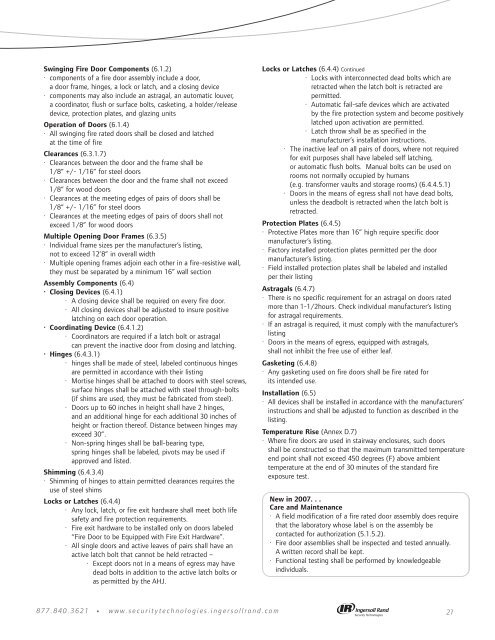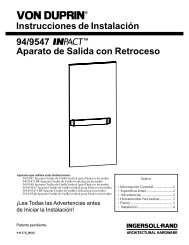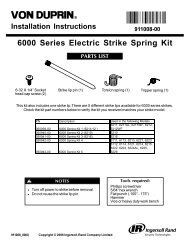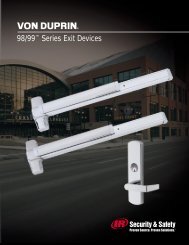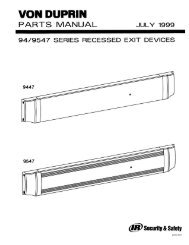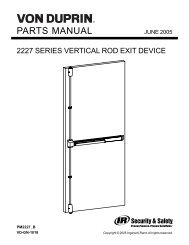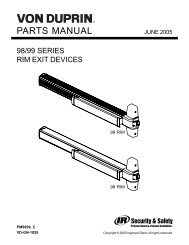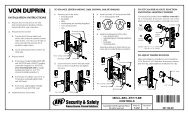Fire, Life Safety & Accessibility Codes - Von Duprin
Fire, Life Safety & Accessibility Codes - Von Duprin
Fire, Life Safety & Accessibility Codes - Von Duprin
Create successful ePaper yourself
Turn your PDF publications into a flip-book with our unique Google optimized e-Paper software.
Swinging <strong>Fire</strong> Door Components (6.1.2)<br />
· components of a fire door assembly include a door,<br />
a door frame, hinges, a lock or latch, and a closing device<br />
· components may also include an astragal, an automatic louver,<br />
a coordinator, flush or surface bolts, casketing, a holder/release<br />
device, protection plates, and glazing units<br />
Operation of Doors (6.1.4)<br />
· All swinging fire rated doors shall be closed and latched<br />
at the time of fire<br />
Clearances (6.3.1.7)<br />
· Clearances between the door and the frame shall be<br />
1/8” +/- 1/16” for steel doors<br />
· Clearances between the door and the frame shall not exceed<br />
1/8” for wood doors<br />
· Clearances at the meeting edges of pairs of doors shall be<br />
1/8” +/- 1/16” for steel doors<br />
· Clearances at the meeting edges of pairs of doors shall not<br />
exceed 1/8” for wood doors<br />
Multiple Opening Door Frames (6.3.5)<br />
· Individual frame sizes per the manufacturer’s listing,<br />
not to exceed 12’8” in overall width<br />
· Multiple opening frames adjoin each other in a fire-resistive wall,<br />
they must be separated by a minimum 16” wall section<br />
Assembly Components (6.4)<br />
· Closing Devices (6.4.1)<br />
· A closing device shall be required on every fire door.<br />
· All closing devices shall be adjusted to insure positive<br />
latching on each door operation.<br />
· Coordinating Device (6.4.1.2)<br />
· Coordinators are required if a latch bolt or astragal<br />
can prevent the inactive door from closing and latching.<br />
· Hinges (6.4.3.1)<br />
· hinges shall be made of steel, labeled continuous hinges<br />
are permitted in accordance with their listing<br />
· Mortise hinges shall be attached to doors with steel screws,<br />
surface hinges shall be attached with steel through-bolts<br />
(if shims are used, they must be fabricated from steel).<br />
· Doors up to 60 inches in height shall have 2 hinges,<br />
and an additional hinge for each additional 30 inches of<br />
height or fraction thereof. Distance between hinges may<br />
exceed 30”.<br />
· Non-spring hinges shall be ball-bearing type,<br />
spring hinges shall be labeled, pivots may be used if<br />
approved and listed.<br />
Shimming (6.4.3.4)<br />
· Shimming of hinges to attain permitted clearances requires the<br />
use of steel shims<br />
Locks or Latches (6.4.4)<br />
· Any lock, latch, or fire exit hardware shall meet both life<br />
safety and fire protection requirements.<br />
· <strong>Fire</strong> exit hardware to be installed only on doors labeled<br />
“<strong>Fire</strong> Door to be Equipped with <strong>Fire</strong> Exit Hardware”.<br />
· All single doors and active leaves of pairs shall have an<br />
active latch bolt that cannot be held retracted –<br />
· Except doors not in a means of egress may have<br />
dead bolts in addition to the active latch bolts or<br />
as permitted by the AHJ.<br />
877.840.3621 • www.securitytechnologies.ingersollrand.com<br />
Locks or Latches (6.4.4) Continued<br />
· Locks with interconnected dead bolts which are<br />
retracted when the latch bolt is retracted are<br />
permitted.<br />
· Automatic fail-safe devices which are activated<br />
by the fire protection system and become positively<br />
latched upon activation are permitted.<br />
· Latch throw shall be as specified in the<br />
manufacturer’s installation instructions.<br />
· The inactive leaf on all pairs of doors, where not required<br />
for exit purposes shall have labeled self latching,<br />
or automatic flush bolts. Manual bolts can be used on<br />
rooms not normally occupied by humans<br />
(e.g. transformer vaults and storage rooms) (6.4.4.5.1)<br />
· Doors in the means of egress shall not have dead bolts,<br />
unless the deadbolt is retracted when the latch bolt is<br />
retracted.<br />
Protection Plates (6.4.5)<br />
· Protective Plates more than 16” high require specific door<br />
manufacturer’s listing.<br />
· Factory installed protection plates permitted per the door<br />
manufacturer’s listing.<br />
· Field installed protection plates shall be labeled and installed<br />
per their listing<br />
Astragals (6.4.7)<br />
· There is no specific requirement for an astragal on doors rated<br />
more than 1-1/2hours. Check individual manufacturer’s listing<br />
for astragal requirements.<br />
· If an astragal is required, it must comply with the manufacturer’s<br />
listing<br />
· Doors in the means of egress, equipped with astragals,<br />
shall not inhibit the free use of either leaf.<br />
Gasketing (6.4.8)<br />
· Any gasketing used on fire doors shall be fire rated for<br />
its intended use.<br />
Installation (6.5)<br />
· All devices shall be installed in accordance with the manufacturers’<br />
instructions and shall be adjusted to function as described in the<br />
listing.<br />
Temperature Rise (Annex D.7)<br />
· Where fire doors are used in stairway enclosures, such doors<br />
shall be constructed so that the maximum transmitted temperature<br />
end point shall not exceed 450 degrees (F) above ambient<br />
temperature at the end of 30 minutes of the standard fire<br />
exposure test.<br />
Newin2007...<br />
Care and Maintenance<br />
· A field modification of a fire rated door assembly does require<br />
that the laboratory whose label is on the assembly be<br />
contacted for authorization (5.1.5.2).<br />
· <strong>Fire</strong> door assemblies shall be inspected and tested annually.<br />
A written record shall be kept.<br />
· Functional testing shall be performed by knowledgeable<br />
individuals.<br />
21


